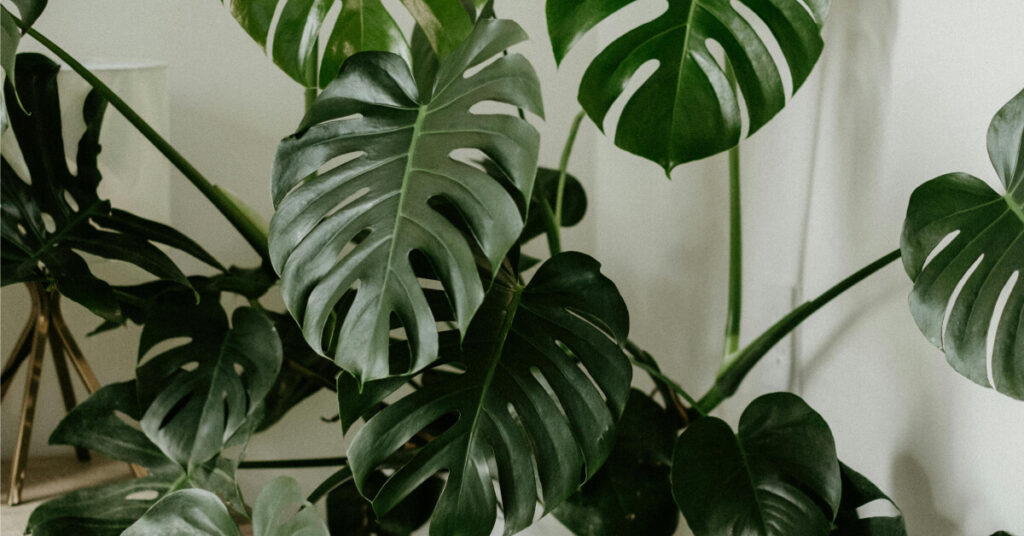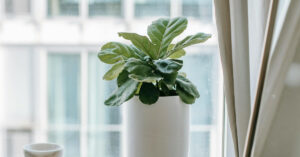Monstera deliciosa
Monstera deliciosa (Swiss Cheese Plant) has captured hearts worldwide with its dramatic, split leaves and impressive size, earning its place as the ultimate statement houseplant. This stunning tropical climbing vine transforms any space into a lush jungle retreat while serving as a living piece of art that commands attention and admiration from every visitor.
Why Monstera Deliciosa Deserves Center Stage in Your Home
Native to the rainforests of Central America, Monstera deliciosa has become synonymous with modern plant parenthood and Instagram-worthy interiors. The plant’s iconic fenestrated leaves—those gorgeous holes and splits that develop as the plant matures—create an architectural presence that works beautifully in both minimalist and maximalist spaces. Beyond its stunning appearance, this natural air purifier helps create healthier indoor environments while bringing the calming presence of nature indoors.
What makes monstera truly special is its dynamic growth habit. Young plants start with solid, heart-shaped leaves, gradually developing the characteristic splits and holes as they mature and climb. This transformation creates an evolving living sculpture that rewards patient plant parents with increasingly dramatic foliage. The plant’s climbing nature, supported by aerial roots, allows it to reach impressive heights while maintaining its lush, tropical appearance.
Care Requirements
Light Requirements
Bright indirect light
Monstera deliciosa thrives in bright, filtered light that mimics the dappled sunlight of its native rainforest understory. Position your plant near east or south-facing windows with sheer curtains, or in rooms with large windows that provide consistent bright light without direct sun exposure. Direct sunlight can scorch the delicate leaves, causing unsightly brown patches and yellowing. While monstera can tolerate medium light conditions, insufficient light leads to smaller leaves, reduced fenestration, and leggy growth.
Watering
Moderate frequency
The key to successful monstera watering lies in maintaining consistent moisture without waterlogging the roots. Water thoroughly when the top 1-2 inches of soil feel dry to the touch, typically every 1-2 weeks during the growing season. The plant appreciates a deep watering that reaches all roots, followed by proper drainage to prevent standing water. During winter months, reduce watering frequency as growth slows and soil takes longer to dry.
Soil Type
Well-draining, chunky potting mix
Monstera requires a soil mix that balances moisture retention with excellent drainage. Use a high-quality aroid mix or create your own by combining standard potting soil with perlite, orchid bark, and a small amount of peat moss or coco coir. This chunky mixture allows air to reach the roots while providing the slightly moist conditions monstera prefers. The soil should feel light and airy rather than dense and compacted.
Temperature
65-80°F (18-27°C)
Monstera deliciosa thrives in the warm, stable temperatures typical of most homes. Maintain temperatures between 65-80°F for optimal growth, avoiding sudden fluctuations that can stress the plant. Keep your monstera away from cold drafts, air conditioning vents, and heating sources. Temperatures below 60°F (15°C) can slow growth significantly and potentially damage the plant.
Humidity
High to medium
Higher humidity levels promote the lush, tropical growth that makes monstera so spectacular. Aim for 50-60% humidity or higher for best results, though the plant can adapt to typical household levels around 40%. Increase humidity using humidifiers, pebble trays filled with water, or by grouping plants together. Higher humidity encourages larger leaves, better fenestration, and healthier aerial root development.
Fertilizing
Regular feeding during growing season
Monstera benefits from consistent nutrition during its active growing period from spring through early fall. Apply a balanced liquid fertilizer monthly, diluted to half the recommended strength to prevent root burn. The plant responds well to organic options like fish emulsion or worm casting tea. Consider supplementing with slow-release fertilizer pellets for steady nutrition throughout the growing season.
Seasonal Care Adjustments
Spring/Summer (Growing Season):
- Water every 1-2 weeks as soil dries
- Monthly fertilizing for robust growth
- Provide support for new growth and aerial roots
- Perfect time for pruning and propagation
Fall/Winter (Slower Growth):
- Reduce watering frequency as growth slows
- Stop fertilizing during dormant period
- Lower light tolerance increases slightly
- Growth naturally slows—this is completely normal
Mature Size and Growth Habits
Monstera deliciosa is a vigorous climber that can reach impressive proportions with proper care and support. Indoor plants typically grow 6-8 feet tall and wide, though they can reach ceiling height given adequate support structures. The plant develops its characteristic fenestrated leaves as it matures, usually after 2-3 years, with splits and holes becoming more dramatic as the plant climbs higher. With proper care, monstera can live for decades, becoming treasured focal points that grow with your family.
Difficulty Level
Moderate
While not as beginner-friendly as pothos or snake plants, monstera deliciosa rewards attentive care with spectacular growth and stunning foliage. The plant requires more specific conditions and regular maintenance but provides clear feedback about its needs through leaf appearance and growth patterns.
Pet and Child Safety
Important: Monstera deliciosa is toxic to pets and children if ingested. The plant contains calcium oxalate crystals that can cause mouth irritation, difficulty swallowing, and digestive upset. All parts of the plant, including leaves and stems, should be kept away from curious pets and small children. Consider placement on high plant stands or in rooms with restricted access if ingestion is a concern.
Varieties to Consider
While Monstera deliciosa is the classic choice, several stunning varieties offer unique characteristics:
- Monstera deliciosa ‘Variegata’: Rare white and green variegated leaves (extremely expensive)
- Monstera deliciosa ‘Thai Constellation’: Lab-created variegation with creamy speckles
- Monstera adansonii: Smaller leaves with more holes, excellent for hanging baskets
- Monstera Peru: Thick, textured leaves with unique ridged patterns
- Monstera siltepecana: Silver-blue juvenile leaves that mature to fenestrated green
Plants That Pair Well with Monstera Deliciosa
Monstera’s tropical nature and substantial size make it an excellent anchor plant for creating lush, jungle-like displays. Its bold foliage provides dramatic backdrop for smaller plants while complementing other statement specimens.
Perfect Companions:
- Fiddle Leaf Fig – Similar light needs with complementary architectural form
- Bird of Paradise – Fellow tropical plant with dramatic, large leaves
- Peace Lily – Elegant white flowers contrast beautifully with monstera’s green foliage
- Rubber Plant – Comparable size and care requirements with different leaf texture
- Philodendron varieties – Related plants with similar humidity and light preferences
Tropical Collections: Create stunning jungle vibes by pairing monstera with other aroids like philodendrons, alocasias, and pothos. These combinations thrive in similar humid conditions and create cohesive tropical displays.
Aesthetic Pairings: Monstera serves as an excellent backdrop plant, allowing smaller specimens like snake plants, ZZ plants, or trailing pothos to shine in front while benefiting from the lush, tropical atmosphere monstera creates.
Common Problems and Solutions
Overwatering
Symptoms: Yellow leaves with brown spots, mushy stems, root rot, fungal odor
Solution: Reduce watering frequency, improve drainage, remove affected roots and repot
Underwatering
Symptoms: Drooping leaves, crispy brown edges, soil pulling from pot sides
Solution: Water thoroughly and establish more consistent watering schedule
Low Humidity
Symptoms: Brown leaf tips, small new leaves, poor fenestration development
Solution: Increase humidity with humidifier, pebble trays, or plant groupings
Insufficient Light
Symptoms: Small leaves, no fenestration, leggy growth, loss of variegation
Solution: Move to brighter location with indirect light, consider grow lights
Pest Issues
Symptoms: Spider mites, thrips, scale insects, mealybugs
Solution: Regular inspection, neem oil treatment, improve air circulation
Support and Training
Providing proper support is crucial for healthy monstera development and achieving those dramatic, fenestrated leaves. As a climbing plant, monstera naturally wants to grow upward, using its aerial roots to attach to surfaces.
Moss Poles: The gold standard for monstera support, moss poles provide a natural climbing surface that aerial roots can penetrate. Keep the moss moist to encourage root attachment and promote larger leaf development.
Wooden Stakes or Trellises: Sturdy wooden supports work well for larger plants, though they don’t provide the same moisture retention as moss poles. Secure climbing stems gently with soft ties.
Aerial Root Management: Don’t trim aerial roots—they’re essential for the plant’s health and climbing ability. Guide them toward the support structure or allow them to grow into the soil for additional stability.
Propagation
Monstera propagation is straightforward and rewarding, allowing you to create new plants or share with fellow plant enthusiasts:
Stem Cutting Method:
- Cut below a node (where aerial roots emerge) with at least one leaf
- Place cutting in water or moist soil
- Keep in bright, indirect light with high humidity
- Roots develop in 2-4 weeks
- Transplant to soil once roots reach 2-3 inches
Air Layering: For larger, more established cuttings, wrap moist sphagnum moss around a node while still attached to the parent plant, then cut once roots develop.
Your Statement Plant for Modern Living
Monstera deliciosa represents the perfect blend of natural beauty and contemporary style, transforming any space into a sophisticated urban jungle. While it requires more attention than truly beginner plants, the reward of watching those iconic splits develop and the plant mature into a stunning focal point makes every bit of care worthwhile.
Whether you’re ready to step up your plant game or seeking that perfect statement piece to anchor your living space, monstera deliciosa delivers unparalleled drama and tropical elegance. Start with a young plant and enjoy the journey as it transforms from a simple houseplant into a living masterpiece that defines your space.




